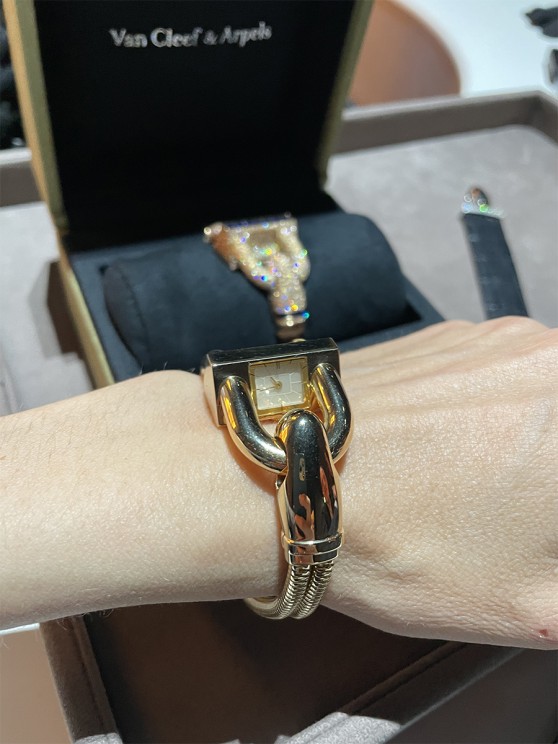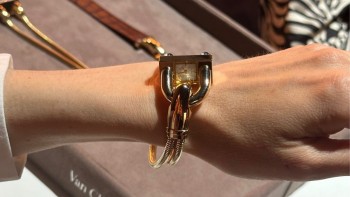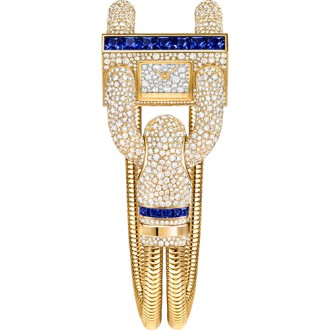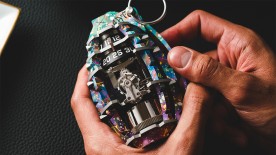The hidden beauty of the lock
According to André Breton (Manifesto of Surrealism, 1924), “the readymades composed by Marcel Duchamp are the first surrealist objects.” Since 1914, Marcel Duchamp paved the way for reinterpreting everyday objects. By designating them as artworks, he elevated their status!
In this spirit, the Cadenas watch transforms a utilitarian form — the padlock — into a jewel-watch, precious and intimate, where time can only be read by the person wearing it. Marketed from 1935, named “Agrafe” in 1936 and then “Cadenas” from 1937, it is part of a broader movement influencing many fields. For example, Elsa Schiaparelli collaborated with Salvador Dalí to create the “Shoe Hat” in 1937, while Cartier’s mechanical jewels blurred the line between function and ornament. Van Cleef & Arpels expressed this vision through both jewelry and watchmaking.
Originally created in yellow gold, it was later adorned with gems — sapphires, rubies (end of 1936), diamonds (1938), and emeralds (1943) — including “white jewelry” interpretations combining diamonds and platinum for the serpent chain (from 1936).
Half rebellious, half traditional
In 1935, the wristwatch still obeyed strict social norms. For a woman, checking the time had to be discreet, or risk seeming improper. According to an ad from the time, the Cadenas’ dial, tilted toward the wrist and disguised as a luxurious bracelet, allowed the wearer to “check the time on the sly.”

This horological trick reflects a paradox dear to the surrealists: to reveal while concealing, and to play with the invisible — think of automatic writing. Catherine Cariou, Heritage Director at Van Cleef & Arpels, even describes it as “a watch for a woman of character.” Behind its apparent discretion, the Cadenas asserts a quiet strength in a decade when emancipated women were claiming new social spaces.
The desirability of industrial aesthetics
The Cadenas watch also owes its existence to the momentum of modernist energy. From the 1920s, artists and jewelers like Raymond Templier, Jean Fouquet, and Gérard Sandoz developed a creative language inspired by machines and emerging technologies. As Sylvie Coëllier wrote, “the machine disrupts the forms of art” in the early 20th century.
In 1937, Paris hosted the International Exposition of Art and Technology in Modern Life, which spread modernism globally. “Modern life” was now recognized as an aesthetic and social ideal. Van Cleef & Arpels, Cartier, Suzanne Belperron, and others embodied this creative revolution, which infused art, fashion, and jewelry. In both watchmaking and jewelry, modernism became an aesthetic manifesto, reinforced by the use of noble materials, clean lines, and often monochrome palettes.
With its prism-shaped case and serpent chain reminiscent of metal cables, the Cadenas echoes this industrial aesthetic. Other creations by the Maison also pushed modernist style: clock towers shaped like skyscrapers, jewelry called “Pylons” or “Ball Bearings.”

A padlock that stands the test of time
The Cadenas was relaunched in 2015 to suit modern lifestyles, with a larger dial for improved readability. In 2025, it celebrates its 90th anniversary — in a dazzling yellow gold version, set with diamonds and sapphires.

Even today, this characterful watch embodies that unique moment when watchmaking questioned the everyday and transformed it into jewelry. It captures an era shaped by modernism, tradition, and rebellion — a set of paradoxes that remains relevant.
Sources :
(1) Van Cleef & Arpels, official site
(2) Journal Le Temps, Géraldine Schonenberg, « Le retour des figures de style : la Cadenas de Van Cleef & Arpels »
(3) Larousse, « Surréalisme »
(4) Sylvie Coëllier. L’étrange pouvoir de la répétition mécanisée dans les arts aux XX et XXIème siècles.
(5) GEM Genève, Vivienne Becker, « New Modernism – 1920s–2020s : The Modernist Movement in Jewels »









